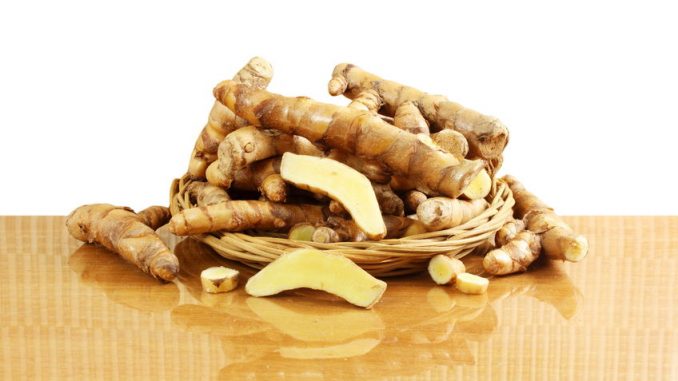
Zedoary or white turmeric is not as well known as some of its other relatives like turmeric and ginger which is a surprise given the substantial history of use this spice has. It was introduced to European travelers by the Arabs along the silk route in the 6th century and was regularly consumed throughout the Middle Ages. Nowadays, ginger and turmeric have superseded this spice.
There are two species in use which are found in Indian grocers. They are Curcuma zedoaria Roscoe or ‘round’ which is small and fat like ginger, and Curcuma zerumbet, or ‘long’ which is long and slender like turmeric. The spice is in the same genus as yellow turmeric. It belongs to the family of gingers, the Zingiberaceae.
The C. zedoaria species is probably the most common of the two and is widely cultivated in Japan, Sri Lanka China and Thailand. It is however a native of north-eastern India.
The underground stem or rhizome has been used for centuries as a traditional herbal medicine. The most common users are in Indian and Indonesia.
It is used to treat spasms especially colic (i.e. is a stomachic), loss of appetite and reduce indigestion. Some users treat inflammation, anxiety and stress, and fatigue. It is a potent mosquito repellant. It has been shown in mice to inhibit the movement of a charcoal meal through the gut and also prevent stress ulcers in this animal.
In India, the spice is also used as a substitute for arrowroot and is used in Indian perfumes and various spiritual rituals. It has a number of names in India: amb halad, garndhmul, and kachur.
Componentry
Zedoary contains a number of interesting compounds associated with medicinal properties. Generally there are a range of sesquiterpenes and monoterpenes which are usually extracted in the essential oil. One major component is a sesquiterpene called dehydrocurdione which has been shown in studies on rats to reduce inflammation (Yoshioka et al., 1998). The compound is strongly associated with reducing chronic arthritis. Helenalin, a sesquiterpene lactone from Arniae flos, has been reported to have an Anti-inflammatory activity. Both these compounds are strong antioxidants.
Side Effects And Safety
Very little information on the safety of zedoary is available however what is known is significant. Zedoary should not be consumed by pregnant women or those who are breast feeding. It might be implicated in causing miscarriages.
It is recommended the spice is not used by women who are menstruating especially those with heavy periods.
Products.
References
Yoshioka, T., Fujii, E., Endo, M. et al. (1998) Antiinflammatory potency of dehydrocurdione, a zedoary-derived sesquiterpene. Inflamm. Res. 47: 476. https://doi.org/10.1007/s000110050361
Leave a Reply